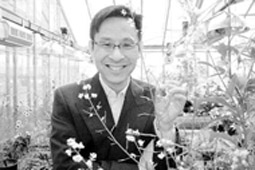One Thousand Plants |
A new initiative launched in November 2008 will acquire gene sequence information for 1000 plant species. Our mandate includes everything from algae to land or aquatic plants, with a particular focus on plants that make medicines or other valuable bioproducts. The project is led from Alberta by myself and Michael Deyholos, and the sequencing will be done at BGI-Shenzhen. An international multidisciplinary consortium has been formed to participate in this research. All of our data will be freely released to the public, specifically through GenBank and other open access websites. This project will begin what we hope is a longer term effort by the research community to study the vast biodiversity that to date has barely been touched by genomics. Not only will this lead to great science, but also, we believe it will lead to commercialization opportunities Doug Horner (Minister of Advanced Education and Technology), URL: http://www.onekp.com Media links: Top U of A scientist to unlock plant DNA Ryan Cormier, Edmonton Journal DNA Project May Lead to Surprise Discoveries By Jim Macdonald,The Canadian Press Alberta project to analyze genomes of 1,000 plants KATHERINE O'NEILL Globe and Mail With C$2M in Funding, 1000 Plants Initiative Takes On Transcriptomes By Julia Karow In Sequence
|
Viral Metagenomics |
In collaboration with Dr. Andrew Mason and other clinicians in the medical school, we are developing novel methods to identify pathogens in clinical samples. Artwork by Gao Feng, of Xinjiang Province China. Look closely and you will see that these classically asian scenes depict real viruses based on their images from electron microscopy, blending art and science in a novel manner, just as we blend genomics and medicine in a novel manner. More information can be found at the Asia Art Resource , at Art Shanghai, or at SOEMO.
|
Chinese Affiliations |
The Beijing Genomics Institute was originally launched in 1999 to sequence 1% of the human genome as China’s contribution to the international consortium that made this data freely available to the scientific community. In 2002, they appeared on the cover of Science for the sequence of the rice genome. Since that time they have published many other high profile results, and in 2007, they launched a subsidiary in Shenzhen (next to Hong Kong) that rapidly grew into one of the highest throughput genome sequencing centers worldwide. For more up-to-date information on the activities at these two organizations, please see their respective websites. URL: http://en.genomics.cn/navigation/index.action |
 Gane Ka-Shu Wong
Gane Ka-Shu Wong
 Gane Ka-Shu Wong (iCORE Chair in Biosystems Informatics), Gregory Taylor (Dean of Science), Randy Goebel (President and CEO of iCORE), William McBlain (Associate Dean of Medicine), David Bailey (President and CEO of Genome Alberta). From the iCORE/1KP launch ceremonies of November 13th in 2008
Gane Ka-Shu Wong (iCORE Chair in Biosystems Informatics), Gregory Taylor (Dean of Science), Randy Goebel (President and CEO of iCORE), William McBlain (Associate Dean of Medicine), David Bailey (President and CEO of Genome Alberta). From the iCORE/1KP launch ceremonies of November 13th in 2008






